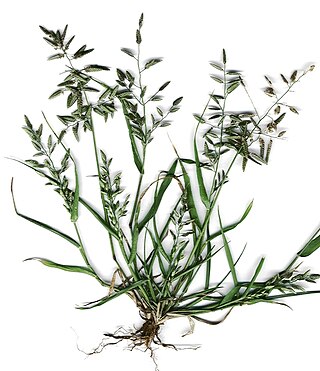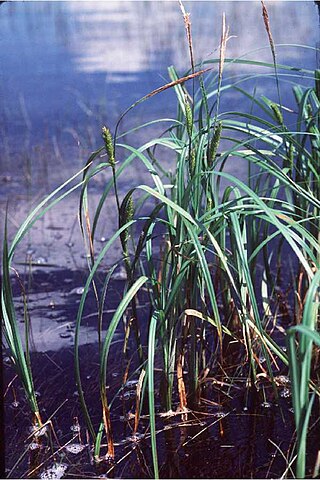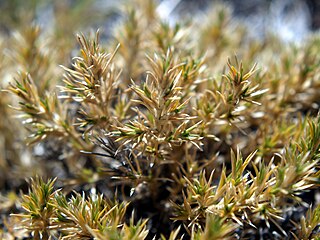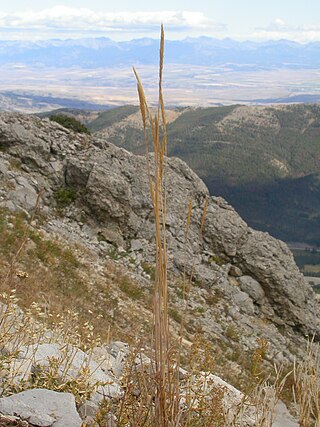
Sporobolus schoenoides is a species of grass known by the common names swamp pricklegrass, swamp timothy, and cowpond grass. This grass is native to Europe but it is present in most other continents where it was introduced and took hold. This is an annual grass with purple-tinted green stems which forms mats and low clumps near water. It has wide-sheathed leaves and large sheaths that partially cover the inflorescences. The clublike inflorescence may exceed 4 centimeters in length and two in width. It is chunky and purple or purplish-green.

Elymus glaucus is a species of grass known as blue wild rye or blue wildrye. This grass is native to North America from Alaska to New York to northern Mexico. It is a common and widespread species of wild rye.

Eragrostis cilianensis is a species of grass known by several common names, including stinkgrass, candy grass, and gray lovegrass.

Juncus drummondii is a species of rush known by the common name Drummond's rush. It is native to western North America from northern Canada and Alaska to New Mexico, where it grows in wet coniferous forest and alpine meadows and slopes. This is a perennial herb forming narrow, erect tufts to about 40 centimeters in maximum height. The leaves are basal and most have no real blades; instead they form a sheath around the stem a few centimeters long. The inflorescence is borne on the side of the stem toward the top. There is a long, cylindrical bract at the base which extends out past the flowers. Each flower is on a thin pedicel. The thick tepals are dark brown, sometimes with green striping and thin, transparent edges. There are six stamens with yellowish anthers, and red stigmas. The fruit is a capsule.

Leersia oryzoides is a species of grass known by the common name rice cutgrass or just cut-grass. It is a widespread grass native to Europe, Asia, and North America and present in many other regions, such as Australia, as an introduced species. This is a rhizomatous perennial grass growing to a maximum height between 1 and 1.5 meters. The leaves are up to about 28 centimeters long and have very rough, minutely toothed edges. The inflorescence is a loose, open array of wavy, hairlike branches bearing rows of spikelets. Each spikelet is a flat fruit with a rough, bristly lemma without an awn, and no glumes. Some of the spikelet branches develop within the sheaths of the leaves and are cleistogamous. This grass is sometimes used for erosion control and restoring wetlands.

Alopecurus saccatus is a species of grass known by the common name Pacific foxtail, or Pacific meadow foxtail.

Aristida divaricata is a species of grass known by the common name poverty threeawn. It is native to the Americas from the central United States to Guatemala. It is a perennial grass forming clumps of unbranched stems up to 70 centimeters tall. Leaves are mostly basal and roll along the edges. The sparse inflorescence is a wide, flat, open array of spikelets that break apart easily. The grain has a twisted tip and three awns up to 2 centimeters long.

Carex atherodes is a species of sedge known by the common name wheat sedge. It is native to Eurasia and much of North America including most of Canada and the United States. It is a very common wetland plant across the American Midwest and areas west. It grows in moist and wet habitat, such as marshes and moist prairie land, and it may grow in shallow water. This sedge produces triangular, hollow stems 30 to 120 centimeters tall. The leaves are hairy, especially on the lower parts, and the leaf sheath is tinted with reddish purple. The inflorescence is up to 60 centimeters long and made up of several spikes; those spikes near the tip are usually staminate, and those lower in the inflorescence are usually pistillate. The tip of each fruit has two or more long, thin teeth.

Carex mertensii is a species of sedge known by the common name Mertens' sedge. It is native to western North America from Alaska to California to Montana, where it grows in moist and wet habitat in mountain forests and meadows. This sedge produces clumps of stems reaching maximum heights between 80 and 120 centimeters. The leaves are small; those toward the bases of the stems are reduced to sheaths only. The inflorescence is a densely packed, bullet shaped cluster of overlapping flowers, mainly hanging on long peduncles. Each inflorescence is generally 2 to 4 centimeters long. Each of the flowers has a dark-colored bract.

Sporobolus alopecuroides is a species of grass known by the common name foxtail pricklegrass. It is native to Europe, the Middle East, and North Africa. It is also known in the western United States as a common and widespread introduced species, especially in sandy areas around water, such as lakesides. It has also been collected at shipping points near Philadelphia but has not been seen there in about a century. This is an annual grass producing mostly upright and unbranching stems, often dark in color, up to about 75 centimeters in maximum height. The green leaves are up to 12 centimeters long, sometimes waxy in texture. The inflorescence is a dense cylindrical panicle of tiny green to purple spikelets.

Munroa squarrosa is a species of grass known by the common name false buffalograss. It is native to North America from central Canada to Chihuahua in Mexico. It can be found in many types of dry, open habitat, including disturbed areas.

Schismus arabicus is a species of grass known by the common name Arabian schismus. It is native to northern Africa, temperate Asia, and it is also known as an introduced species in the southwestern United States. It grows in many types of habitat, including disturbed areas. It is an annual grass with stems growing up to 16 centimeters long and lined with threadlike leaves. The short inflorescence bears spikelets under a centimeter long.

Schismus barbatus is a species of grass known as common Mediterranean grass and kelch-grass. It is native to Eurasia, and it is also known as an introduced species in the southwestern United States. It grows in many habitats, including disturbed areas. It is an annual grass growing in small clumps. The stems grow up to 27 centimeters long and are lined with threadlike leaves. The short inflorescence bears spikelets under a centimeter long.

Setaria verticillata is a species of grass known by the common names hooked bristlegrass, rough bristle-grass and bristly foxtail. It is native to Europe, but it is known on most continents as an introduced species and often a noxious weed. It is a hardy bunchgrass which grows in many types of urban, cultivated, and disturbed habitat. It is a weed of many types of agricultural crops, growing in vineyards and fields. Herbicide-resistant strains have been noted.

Sporobolus foliosus is a species of grass known by the common name California cordgrass. It was reclassified from Spartina foliosa after a taxonomic revision in 2014. It is native to the salt marshes and mudflats of coastal California and Baja California, especially San Francisco Bay. It is a perennial grass growing from short rhizomes. It produces single stems or clumps of thick, fleshy stems that grow up to 1.5 meters tall. They are green or purple-tinged. The long, narrow leaves are flat or rolled inward. The inflorescence is a narrow, dense, spike-like stick of branches appressed together, the unit reaching up to 25 centimeters long. The lower spikelets are sometimes enclosed in the basal sheaths of upper leaves.

Trisetum canescens is a species of grass known by the common names tall trisetum and tall false oat.

Trisetum spicatum is a species of grass known by the common name spike trisetum and spike false oat. It is native to North America, Eurasia, and South America. In North America it occurs throughout northern regions, including northern sections of the United States and most all of Canada, its range continuing to Greenland. It is widespread throughout the Canadian Arctic Islands. The grass occurs in a variety of Arctic and alpine habitat types, as well as many types of mountainous habitat in regions farther south. It is a perennial grass forming clumps of erect stems ranging in height from just a few centimeters to over one meter. The narrow leaves are mostly located around the bases of the densely clumped stems. The inflorescence is a narrow spike a few centimeters long or up to 30 to 50 centimeters in maximum length. The spikes are green to purple or brownish and shiny.

Dichanthelium clandestinum is a species of grass known by the common name deertongue. It is native to eastern North America, including eastern Canada and the eastern United States.

Disakisperma dubium is a species of grass known by the common names green sprangletop and zacate gigante. It is native to the Americas, where it is distributed from the United States to Argentina.

Setaria palmifolia is a species of grass known by the common names palmgrass, highland pitpit, hailans pitpit, short pitpit, broadleaved bristlegrass, and knotroot. It is native to temperate and tropical Asia. It is known elsewhere as an introduced, and often invasive, species, including in Australia, New Zealand, many Pacific Islands, and the Americas.




















